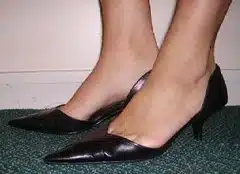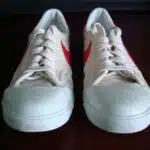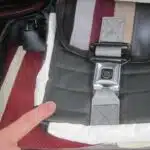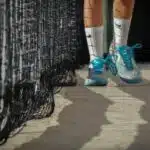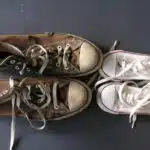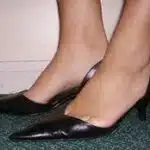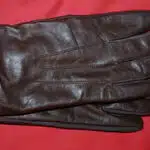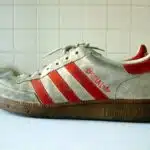As a shoe care expert, I have encountered numerous cases of creases and dents on shoes. These unsightly marks can ruin the appearance of even the most pristine pair of footwear. However, with the right techniques and tools, it is possible to restore your shoes to their former glory.
Creases and dents are often caused by wear and tear or improper storage. They can be particularly frustrating for those who value the appearance of their shoes. Fortunately, there are several methods that can be employed to remove these imperfections without causing further damage. In this article, I will discuss some of the most effective techniques for getting creases and dents out of shoes, as well as provide tips for preventing them from occurring in the first place. Whether you are a shoe enthusiast or simply want your footwear to look its best, this guide will prove invaluable in maintaining a polished appearance for your shoes.
Understanding The Causes Of Creases And Dents
Imagine your favorite pair of shoes, the ones that make you feel confident and stylish. Over time, you may notice unwanted creases and dents forming in the leather. These blemishes can be frustrating, but understanding their causes can help prevent them from happening again in the future.
One of the primary causes of creases and dents in shoes is repetitive movement. When you take a step, the leather bends and stretches, which can create wrinkles over time. This is especially true for shoes with thinner leather or those that are worn frequently.
Another factor that contributes to creases and dents is moisture. Leather is a porous material that absorbs water easily. If your shoes get wet from rain or snow, they may develop unsightly marks or even lose their shape entirely.
To prevent these issues from occurring, it’s important to take good care of your shoes. Proper storage and regular cleaning can help keep them looking their best for years to come. Additionally, investing in high-quality shoe trees can help maintain the shape of your footwear while it’s not being worn. In the next section, we’ll discuss how to identify what type of leather your shoes are made from so you can choose appropriate care techniques accordingly.
Identifying The Type Of Leather
Understanding the Causes of Creases and Dents in shoes is a crucial first step towards treating them. However, identifying the type of leather that your shoes are made of is equally important. Different types of leather react differently to treatments, and understanding this can help you avoid damaging your shoes.
Types of leather to avoid include synthetic or bonded leather, which do not crease as naturally as genuine leather but instead tend to crack and peel over time. On the other hand, full-grain or top-grain leathers are more susceptible to creasing due to their natural elasticity. In general, higher quality leathers will have fewer creases than lower quality leathers.
How leather quality affects creasing is determined by factors such as tanning process, thickness, and age. Thicker leathers are less prone to creases, while thinner ones often show heavy creasing in high-stress areas like the toe box and vamp. Similarly, older leathers may be more brittle and prone to cracking than newer ones.
Now that you know how different types of leather affect creasing, it’s time to prepare your shoes for treatment. By following proper cleaning techniques and using appropriate products for your shoe’s specific type of leather, you can help reduce existing creases and prevent new ones from forming. In the next section, we will explore how to properly prepare your shoes for treatment so that you can achieve optimal results.
Preparing Your Shoes For Treatment
To prepare your shoes for treatment, it is important to start with the proper tools. Choosing the right shoe tree can make all the difference in preventing creases and dents from forming. A shoe tree is a device that is inserted into the shoe to help maintain its shape while not being worn. It works by applying pressure to the leather, stretching it back into its original form.
It’s also crucial to understand how humidity affects leather. Leather is a porous material that can absorb moisture from the air. Humidity levels that are too high or too low can cause leather to become stiff, crack, or lose its shape over time. To prevent this damage from occurring, store your shoes in a cool, dry place with moderate humidity levels.
By properly preparing your shoes for treatment, you can ensure that they remain in good condition for years to come. In the next section, we will discuss how using a shoe tree can further prevent creases and dents from forming on your leather shoes.
Using A Shoe Tree To Prevent Creases And Dents
Shoe trees are an essential tool for preventing creases and dents in shoes. These devices are designed to maintain the shape of shoes and prevent them from folding or bending, especially when they are not being worn. By inserting a shoe tree into your footwear after each use, you can ensure that your shoes retain their original form and avoid the unsightly creases that can form over time.
Aside from preserving the appearance of your shoes, using a shoe tree also has other benefits. For one, it helps to maintain the integrity of the shoe’s construction by redistributing tension throughout its structure. This is particularly important for leather shoes as they tend to stretch and lose their shape over time due to wear and tear. Additionally, shoe trees help to absorb any excess moisture inside your shoes, which can cause odors or lead to mold growth.
If you do not have access to a shoe tree, there are alternative methods for preventing creases in your shoes. One option is stuffing them with tissue paper or old newspaper after each use. While this may not be as effective as a shoe tree, it can still help maintain the shape of your shoes until you are able to invest in a proper shoe tree. Another option is simply rotating through different pairs of shoes regularly so that each pair has enough time to rest and regain its shape before being worn again.
Using a shoe tree is an effective way to prevent creases and dents in your favorite pairs of shoes. Not only does it help preserve their appearance, but it also maintains their structural integrity while absorbing any excess moisture inside them. However, if you do not have access to a shoe tree, there are alternative methods such as stuffing them with tissue paper or rotating through different pairs of shoes regularly. In the next section, we will explore another method for removing creases from leather shoes – using a hair dryer.
Using A Hair Dryer To Remove Creases
As we discussed in the previous section, using a shoe tree is an effective way to prevent creases and dents from forming in your shoes. However, sometimes prevention is not enough, and you may need to remove existing creases and dents. One method for doing so is using a hair dryer.
Using a hair dryer to remove creases involves heating the affected area of the shoe with hot air while simultaneously manipulating the leather until it regains its shape. This method can be useful for removing minor creases and dents, but it does have its pros and cons. On the one hand, it’s a relatively simple and inexpensive solution that can be done at home with minimal effort. On the other hand, if not done correctly, using a hair dryer could damage your shoes or even make the problem worse.
To use this method effectively, there are some best practices to keep in mind. First, make sure your shoes are clean and dry before beginning. Next, use the lowest heat setting on your hair dryer to avoid damaging the leather. It’s also important to keep the hair dryer moving around constantly rather than focusing on one spot for too long. Finally, use gentle pressure when manipulating the leather back into place.
In summary, using a hair dryer is one way you can remove creases and dents from your shoes at home. While it has its pros and cons, following best practices will help you achieve success without causing any damage or making matters worse. In the next section we will discuss another method for removing dents – using a clothes iron – which requires more caution than using a hairdryer but can be just as effective if done correctly.
Using A Clothes Iron To Remove Dents
When it comes to removing dents from shoes, using a clothes iron can be an effective method. However, it is important to exercise caution and follow proper safety protocols to avoid damaging the shoe or injuring oneself. To begin, make sure the iron is set on a low heat setting and does not have water in it. Place a cloth or towel over the dent and gently press the iron on top of it for a few seconds at a time until the dent starts to lift.
While using an iron can be effective, there are alternative methods that can also work well for removing dents from shoes. One option is to fill the shoe with wet newspaper or tissue paper and let it dry completely. As the paper dries, it will expand and help push out any dents or creases in the shoe. Another method is to use a hair dryer on high heat to blow hot air onto the dent while pressing down on it with your fingers.
When using an iron to remove dents from shoes, it is important to always prioritize safety first. Keep children and pets away from the area where you are working, and never leave the iron unattended. Additionally, make sure there is no water in the iron as this can cause damage to both the shoe and yourself. By following these guidelines and exploring alternative methods for dent removal, you can effectively restore your shoes back to their original shape without causing any unnecessary damage.
Moving forward, another option for removing creases and dents from shoes is by using a steamer. This method involves heating up water in a container until steam is produced, then holding the shoe over the steam while applying pressure with your fingers or other tools. While this technique may require some practice to perfect, it can be highly effective in restoring shape and structure to your footwear.
Using A Steamer To Remove Creases And Dents
As the saying goes, “a good pair of shoes can take you to great places.” However, constant wear and tear can cause creases and dents in your favorite footwear. Fortunately, there are various methods to bring back the original shape of your shoes. In the previous section, we discussed using a clothes iron to remove dents. In this section, we will talk about using a steamer to remove creases and dents.
One of the benefits of steaming is that it works well on delicate materials such as suede and leather. Steamers use warm water vapor to soften the fibers of the shoe’s material, making it easier to reshape. Additionally, steamers are also effective in removing any unpleasant odor from your shoes due to their sanitizing properties.
There are different types of steamers available in the market today such as handheld steamers and standing steamers. Handheld steamers are ideal for smaller areas while standing steamers work best for larger surfaces like boots or sneakers. Whichever type you choose, make sure to follow manufacturer instructions carefully for proper usage.
Transitioning into our subsequent section on using a shoe stretching spray, it is important to note that steaming should be done before stretching your shoes for maximum effectiveness. With these tips in mind, let’s move on to our next section on how to use a shoe stretching spray.
Using A Shoe Stretching Spray
Shoe stretching spray is a popular solution for people who want to get rid of creases and dents in their shoes. This spray works by softening the material of the shoe, which makes it easier to stretch and shape into the desired form. There are several benefits to using a shoe stretching spray, such as its ability to restore the original shape of shoes without causing any damage or discoloration.
One alternative to using a shoe stretching spray is placing damp newspaper inside the shoes and allowing them to dry overnight. This method can certainly work, but it may not be as effective as using a shoe stretching spray. Another alternative is using a hair dryer to warm up the area around the crease or dent and then trying to reshape it with your hands. However, this method can be risky as it may cause damage or discoloration to your shoes.
If you decide to use a shoe stretching spray, make sure that you read the instructions carefully before applying it on your shoes. It is also important that you use high-quality products that are specifically designed for this purpose. Once you have sprayed your shoes, make sure that you wear them immediately so that they can conform to your feet’s unique shape.
Transition: Using a leather conditioner is another effective way of maintaining the quality of your shoes. In the next section, we will discuss how this technique works and what benefits it offers.
Using A Leather Conditioner
Transition: Now that we have discussed the benefits of using a shoe stretching spray, let us move onto the next step in restoring your shoes – using a leather conditioner.
Leather is a natural material and it requires regular conditioning to maintain its suppleness and prevent cracks from forming. Conditioning your shoes not only helps to remove creases and dents but also extends their lifespan. Leather conditioners work by moisturizing the leather, thereby making it more flexible and resistant to damage caused by wear and tear.
When choosing a leather conditioner for your shoes, it is important to select one that is specifically designed for footwear. Some of the best leather conditioners for shoes include products made by reputable brands such as Saphir Renovateur, Lexol Leather Conditioner, and Bickmore Bick 4. These conditioners are gentle on the leather and contain nourishing ingredients that help to maintain its natural properties while protecting against water damage.
Incorporating a regular conditioning routine into your shoe care regimen not only restores the appearance of your shoes but also protects them from future damage. By applying a high-quality conditioner every few months or as needed, you can ensure that your shoes remain in excellent condition for years to come. In our next section, we will discuss how to use shoe cream or polish to further enhance the appearance of your rejuvenated footwear.
Using Shoe Cream Or Polish
When it comes to removing creases and dents from shoes, using shoe cream or polish can be an effective option. One of the key factors in achieving a successful outcome is color matching. It’s important to choose a cream or polish that closely matches the color of your shoes to avoid unsightly discoloration or staining.
Once you’ve found the right color, application techniques become critical. Start by cleaning your shoes with a soft cloth and allowing them to dry completely. Then, apply a small amount of cream or polish to a clean cloth and rub it into the affected area in circular motions. Be sure to buff away any excess product with another clean cloth for a smooth finish.
Incorporating shoe cream or polish into your shoe care routine can help improve their appearance and extend their lifespan. Remember to choose the correct color and use proper application techniques for optimal results.
Next up, we’ll explore some important tips for using a heat gun with caution when dealing with creases and dents in your shoes.
Using A Heat Gun With Caution
When it comes to removing creases and dents from your shoes, using a heat gun is an effective method that should be approached with caution. Before using a heat gun, make sure you have the proper safety equipment, including heat-resistant gloves and eye protection. It’s also important to read and follow the manufacturer’s instructions carefully.
When using a heat gun, hold it at least six inches away from your shoes to avoid burning or melting the material. Move the heat gun in circular motions over the affected area until it becomes pliable, then use your fingers or a shoe horn to reshape the leather. Be careful not to overheat the material, as this can cause irreparable damage.
If you’re not comfortable using a heat gun or would like to try alternative methods for removing creases and dents from your shoes, there are several options available. These include stuffing your shoes with newspaper or shoe trees to help reshape them over time, using a leather conditioner or oil to soften the material and reduce creasing, or seeking professional repair services.
Transition:
While attempting these methods can be effective for minor creases and dents, more severe damage may require seeking professional repair. In the next section, we will discuss what to look for when choosing a professional shoe repair service.
Seeking Professional Repair
Imagine you’ve just purchased a brand new pair of shoes, and they’re your absolute favorite. You wear them everywhere, but after a few months, you notice some creases and dents that have formed on the leather. While there are DIY methods to fix these issues, sometimes it’s best to leave it to the professionals.
Finding Professionals: When looking for professional shoe repair services, start by doing research online. Look for shops in your area with good reviews and ratings from previous customers. You can also ask friends or family members if they have any recommendations. Once you’ve found a few potential options, call them and ask about their experience repairing shoes and what types of repairs they offer.
Cost of Professional Repairs: The cost of professional shoe repairs varies depending on the extent of the damage and the type of repair needed. Some repairs may be as simple as smoothing out creases, while others may require more extensive work. When getting a quote from a professional repair shop, be sure to ask about any additional costs like materials or labor fees. In general, though, it’s worth investing in professional repairs rather than risking further damage by attempting DIY fixes.
- Check online reviews before choosing a repair shop
- Ask friends or family for recommendations
- Call shops to inquire about their experience and services offered
- Ask for an estimate before agreeing to repairs
- Consider the value of investing in professional repairs rather than attempting DIY fixes
In summary, while there are DIY methods for fixing creases and dents in shoes, sometimes it’s best to leave it to the professionals. When seeking out a repair shop, do your research beforehand by checking reviews online or asking friends for recommendations. Keep in mind that the cost of professional repairs can vary depending on the extent of damage and type of repair needed but investing in these services is often worth it in order to maintain the integrity and longevity of your favorite pair of shoes. Next up, we’ll discuss some tips for properly storing your shoes to prevent damage in the first place.
Tips For Storing Your Shoes
Seeking professional repair for creases and dents in shoes can be a great option, but it may not always be necessary. There are some DIY methods that can help preserve the shape of your shoes and prevent further damage from occurring. One effective solution is using a shoe tree to keep your shoes in their original shape when they are not being worn. Additionally, stuffing your shoes with tissue paper or newspaper can help remove any existing dents.
However, prevention is always better than cure. Proper shoe storage and organizing tips can go a long way in preserving the shape of your shoes and limiting the occurrence of creases and dents. When storing your shoes, it is important to avoid overcrowding them as this can lead to unnecessary pressure on the leather or fabric. You should also avoid damp areas as moisture can cause damage to certain types of materials. A dry and well-ventilated space such as a closet or wardrobe shelf would be ideal.
Maintenance routines such as regular cleaning and conditioning can also help maintain the integrity of your shoes. When cleaning, use a soft bristled brush or cloth to gently remove dirt or dust from the surface of the shoe. Conditioning with a high-quality leather conditioner will help keep the material supple and prevent cracking or drying out. By following these simple steps, you can ensure that your shoes look their best for longer periods of time.
Moving forward, let’s discuss some tips for wearing your shoes without causing unnecessary damage.
Tips For Wearing Your Shoes
Shoe maintenance is essential to keep your footwear looking as good as new for longer. Proper care of shoes not only enhances their appearance but also extends their lifespan. It is advisable to invest in quality shoe care products to protect and maintain the condition of your shoes.
Footwear protection is a critical aspect of shoe maintenance. Apply a water-resistant spray on your shoes before wearing them, especially if they are made of suede or leather. This will create a barrier that prevents water from penetrating the material and causing stains or damage. Regular cleaning and conditioning will also help to keep your shoes in excellent condition.
To ensure that your shoes last longer, rotate them frequently. Avoid wearing the same pair every day as it causes wear and tear, leading to creases and dents. Allow your shoes to breathe by alternating them with other pairs and avoid leaving them in damp or humid places for extended periods. Proper storage also plays a crucial role in maintaining the shape of your shoes; store them in a cool, dry place away from direct sunlight.
As you start caring for your shoes regularly, you may have some questions about shoe care practices. In the next section, we will address some frequently asked questions about shoe care, providing you with expert tips on how best to take care of different types of footwear.
Frequently Asked Questions About Shoe Care
As the saying goes, prevention is better than cure. The same applies to shoe maintenance. To avoid common shoe problems such as creases and dents, it is essential to take good care of your shoes from the start. Regular cleaning, polishing, and conditioning can go a long way in maintaining the shape of your shoes.
However, if you do find yourself with creased or dented shoes, there are a few methods that may help. One option is to stuff your shoes with tissue paper or shoe trees overnight to help reshape them. Another method involves using steam from an iron or kettle to soften the leather before reshaping it by hand. Be careful not to over-steam or burn the leather in the process.
In some cases, it may be best to consult a professional cobbler for more extensive damage. They have specialized tools and techniques that can restore your shoes’ shape and prolong their lifespan. Remember that investing time and effort into proper shoe care can save you money in the long run by avoiding costly repairs or replacements.
Conclusion
As a shoe care expert, it is essential to understand the causes of creases and dents in shoes. Whether it’s from walking, improper storage or natural wear and tear, every type of leather reacts differently. Identifying the right treatment for each situation is vital.
There are several ways to fix creased and dented shoes. Using a shoe tree can prevent future damage while a hair dryer can help remove existing creases. However, some cases require professional repair. Proper shoe care involves not only fixing damage but also storing and wearing them correctly.
Remember that just like any other investment, taking good care of your shoes will prolong their lifespan and keep them looking their best. With these tips in mind, you’ll be able to enjoy your favorite pair for years to come!
Image Credits
- “Sexy Shoes 26” by cuteheels (featured)

